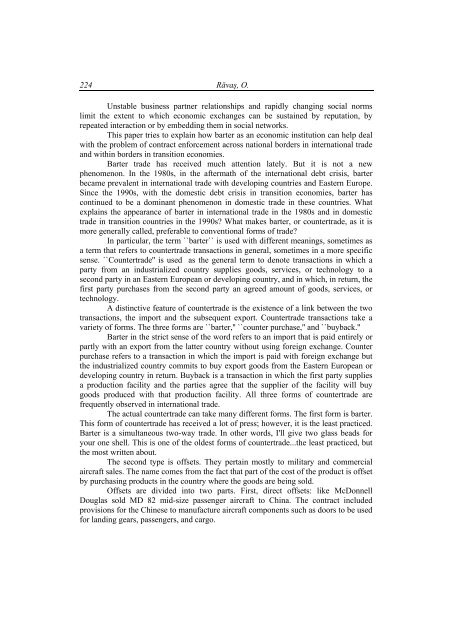annals of the university of petroÅani â¼ economics â¼ vol. xi - part i ...
annals of the university of petroÅani â¼ economics â¼ vol. xi - part i ...
annals of the university of petroÅani â¼ economics â¼ vol. xi - part i ...
Create successful ePaper yourself
Turn your PDF publications into a flip-book with our unique Google optimized e-Paper software.
224 Răvaş, O.<br />
Unstable business <strong>part</strong>ner relationships and rapidly changing social norms<br />
limit <strong>the</strong> extent to which economic exchanges can be sustained by reputation, by<br />
repeated interaction or by embedding <strong>the</strong>m in social networks.<br />
This paper tries to explain how barter as an economic institution can help deal<br />
with <strong>the</strong> problem <strong>of</strong> contract enforcement across national borders in international trade<br />
and within borders in transition economies.<br />
Barter trade has received much attention lately. But it is not a new<br />
phenomenon. In <strong>the</strong> 1980s, in <strong>the</strong> aftermath <strong>of</strong> <strong>the</strong> international debt crisis, barter<br />
became prevalent in international trade with developing countries and Eastern Europe.<br />
Since <strong>the</strong> 1990s, with <strong>the</strong> domestic debt crisis in transition economies, barter has<br />
continued to be a dominant phenomenon in domestic trade in <strong>the</strong>se countries. What<br />
explains <strong>the</strong> appearance <strong>of</strong> barter in international trade in <strong>the</strong> 1980s and in domestic<br />
trade in transition countries in <strong>the</strong> 1990s What makes barter, or countertrade, as it is<br />
more generally called, preferable to conventional forms <strong>of</strong> trade<br />
In <strong>part</strong>icular, <strong>the</strong> term ``barter`` is used with different meanings, sometimes as<br />
a term that refers to countertrade transactions in general, sometimes in a more specific<br />
sense. ``Countertrade'' is used as <strong>the</strong> general term to denote transactions in which a<br />
<strong>part</strong>y from an industrialized country supplies goods, services, or technology to a<br />
second <strong>part</strong>y in an Eastern European or developing country, and in which, in return, <strong>the</strong><br />
first <strong>part</strong>y purchases from <strong>the</strong> second <strong>part</strong>y an agreed amount <strong>of</strong> goods, services, or<br />
technology.<br />
A distinctive feature <strong>of</strong> countertrade is <strong>the</strong> e<strong>xi</strong>stence <strong>of</strong> a link between <strong>the</strong> two<br />
transactions, <strong>the</strong> import and <strong>the</strong> subsequent export. Countertrade transactions take a<br />
variety <strong>of</strong> forms. The three forms are ``barter,'' ``counter purchase,'' and ``buyback.''<br />
Barter in <strong>the</strong> strict sense <strong>of</strong> <strong>the</strong> word refers to an import that is paid entirely or<br />
<strong>part</strong>ly with an export from <strong>the</strong> latter country without using foreign exchange. Counter<br />
purchase refers to a transaction in which <strong>the</strong> import is paid with foreign exchange but<br />
<strong>the</strong> industrialized country commits to buy export goods from <strong>the</strong> Eastern European or<br />
developing country in return. Buyback is a transaction in which <strong>the</strong> first <strong>part</strong>y supplies<br />
a production facility and <strong>the</strong> <strong>part</strong>ies agree that <strong>the</strong> supplier <strong>of</strong> <strong>the</strong> facility will buy<br />
goods produced with that production facility. All three forms <strong>of</strong> countertrade are<br />
frequently observed in international trade.<br />
The actual countertrade can take many different forms. The first form is barter.<br />
This form <strong>of</strong> countertrade has received a lot <strong>of</strong> press; however, it is <strong>the</strong> least practiced.<br />
Barter is a simultaneous two-way trade. In o<strong>the</strong>r words, I'll give two glass beads for<br />
your one shell. This is one <strong>of</strong> <strong>the</strong> oldest forms <strong>of</strong> countertrade...<strong>the</strong> least practiced, but<br />
<strong>the</strong> most written about.<br />
The second type is <strong>of</strong>fsets. They pertain mostly to military and commercial<br />
aircraft sales. The name comes from <strong>the</strong> fact that <strong>part</strong> <strong>of</strong> <strong>the</strong> cost <strong>of</strong> <strong>the</strong> product is <strong>of</strong>fset<br />
by purchasing products in <strong>the</strong> country where <strong>the</strong> goods are being sold.<br />
Offsets are divided into two <strong>part</strong>s. First, direct <strong>of</strong>fsets: like McDonnell<br />
Douglas sold MD 82 mid-size passenger aircraft to China. The contract included<br />
provisions for <strong>the</strong> Chinese to manufacture aircraft components such as doors to be used<br />
for landing gears, passengers, and cargo.

















